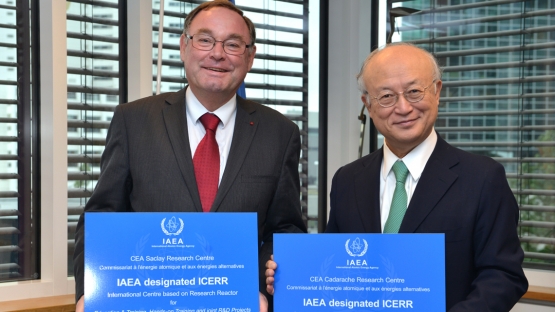Research centres of the French Alternative Energies and Atomic Energy Commission (CEA) will make their research reactors and other facilities available to institutions from IAEA Member States for education, and joint research and development (R&D) projects, Daniel Verwaerde, CEA’s General Administrator announced today.
As the first designated International Centre based on Research Reactors (ICERR) under a new scheme launched by the IAEA last year, CEA’s research centres in Saclay and Cadarache will become international research hubs.
“Such centres will enable researchers from IAEA Member States, especially developing states, to gain access to research reactor capabilities and develop human resources efficiently, effectively, and, probably, at a lower cost,” Mr Amano said at a ceremony at IAEA Headquarters in Vienna, during which he awarded the designation to the CEA.
“The ICERR scheme will also contribute to enhanced utilization of existing research reactor facilities and, by fostering cooperation, to the development and deployment of innovative nuclear technologies,” he added.
The designation was the result of a rigorous process, including the review of the application and support documentation, an audit mission performed at the CEA sites, as well as a comprehensive evaluation and recommendation by an international selection committee made up of representatives from the global research reactor community and IAEA staff, explained Andrea Borio di Tigliole, Head of the Research Reactor Section at the IAEA. The goal of the scheme is to help Member States, mainly without research reactors, to gain timely access to research reactor infrastructure to carry out nuclear research and development and build capacity among their scientists.
CEA plans to welcome 15 to 20 researchers at its centres per year, Verwaerde said.
“I am very glad to receive this ICERR designation for our proposal centered on our Jules Horowitz Reactor and its ancillary facilities,” Mr Verwaerde said. “It is really important, because many countries are willing to develop their technical skills in research reactors for their future nuclear program. I hope that other countries will soon join us under the ICERR designation, in order to have ICERR presence in each region of the world. We are looking forward to share experience and lessons learned with them.”


